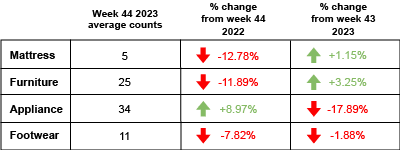In October, the United States experienced a notable shift as overall sales recorded a decline for the first time in seven months.
This week, we explore what happened last month and take a look at the surprising data behind the disappearing act of free returns.
THIS WEEK’S HIGHLIGHTS
- Social success: Getting to understand social media data’s rising influence on business success.
- Doorcounts is becoming Trakwell.ai: Click HERE to learn more.
OUT NOW – Q2 2023 Benchmark Report: Click HERE to see how your store compares to the industry average.
FOOT TRAFFIC INDEX

FOOT TRAFFIC TRENDS
Industry insights so you can convert your foot traffic into more sales.
US Retail Sales
Adjusted for seasonal variations but not inflation, retail sales dropped by 0.1% in October compared to the previous month, according to the Commerce Department’s report on Wednesday.
While that’s the first monthly decline since March, it was a smaller decline than economists were expecting. A drop-off in sales of some big-ticket items helped drive October’s decline. Car sales fell 1.1% in October from September, while furniture sales declined 2% during the same period.
The Consumer Price Index rose 3.2% in October from a year earlier, down from September’s annualized 3.7% rise, marking the weakest pace since March 2021, the Bureau of Labor Statistics reported Tuesday.
One month’s data doesn’t make a trend, but economists are widely expecting the US economy to cool further in the final months of the year, including inflation, under the weight of several economic headwinds.
Click HERE to read more.
Farewell Free Returns
About 40% of retailers are charging return fees this year, according to retail technology company Narvar. That’s up from 31% in 2022 as companies work to improve profitability amid dwindling consumer demand and rising costs.
Processing a return can cost as much as 66% of a $50 item, according to one estimate from logistics technology company Optoro. It’s costly enough that retailers like Amazon and Walmart will occasionally let a customer keep their refunded item instead of making them ship it back.
Although charging for returns will make returns more challenging for consumers, there are positives. Not only will consumers become more conscious of their purchases, the environment will thank us. Optoro estimates that returned inventory in the U.S. last year created 9.5 billion pounds of landfill waste and 24 million metric tons of carbon dioxide emissions.
Click HERE to learn more about the future of returns.
Retail Snippets
A new standard: NRF releases principles for the use of artificial intelligence in the retail sector.
Short lived: Serta Simmons CEO Charlie Eitel resigns after 3 months.
Ecommerce Tracker: 6 trends will define retail and e-commerce in 2024.
Random Irrelevance
Weekend light show: One of the fastest meteor showers of the year is peaking this weekend.
Iceland watch: Iceland officials say ‘high’ volcanic eruption possibility as hundreds of earthquakes hit region.
Dark matter: Dark matter-hunting satellite ARRAKIHS to launch in 2030. Here’s how it will work.